Understanding Pediatric Heart Health
Heart conditions in children, ranging from congenital defects present at birth to acquired diseases developed after birth, can profoundly impact a child's health and development. Early recognition of the signs and symptoms is vital to ensure timely diagnosis and treatment. This article explores the common pediatric heart conditions, their symptoms across various age groups, diagnostic approaches, and considerations for choosing pediatric cardiology care, equipping parents and caregivers with essential knowledge to detect and respond to potential heart issues in children.
Overview of Pediatric Heart Conditions
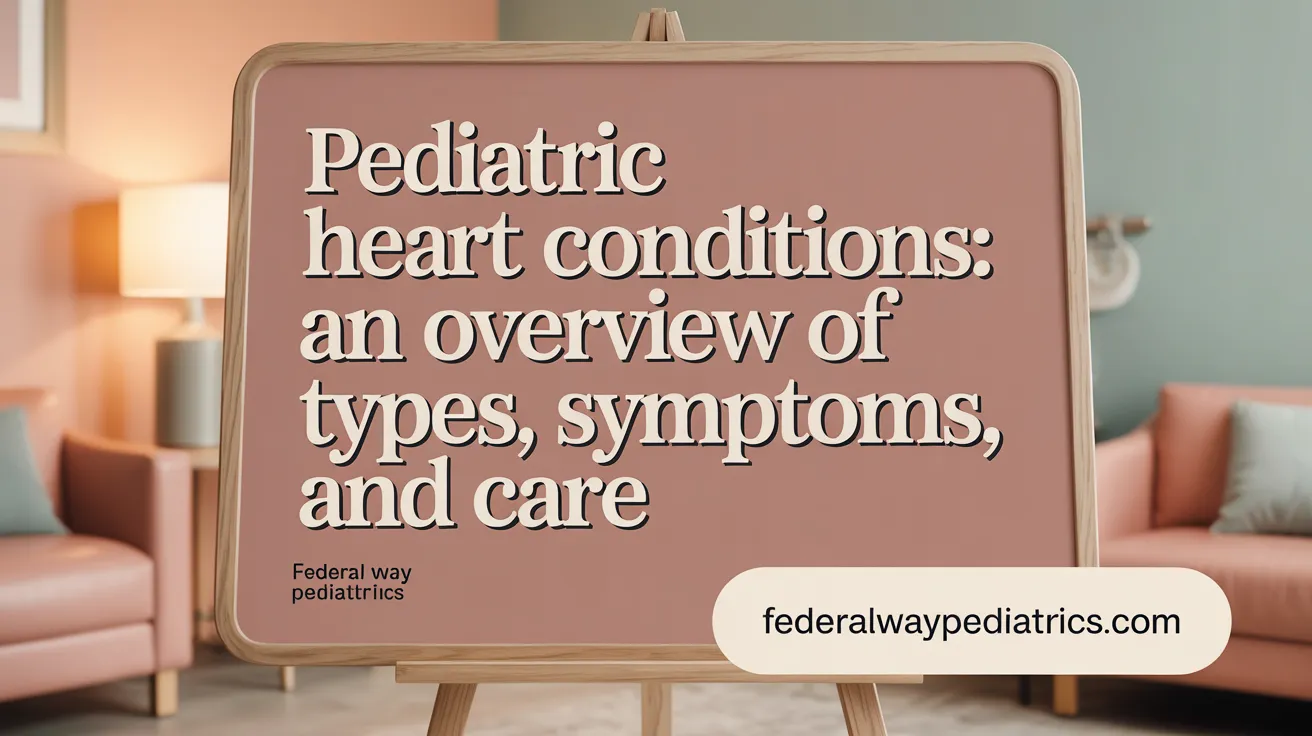
What are the common types and prevalence of heart conditions in children?
Congenital heart defects (CHDs) are the most frequent heart conditions in children, occurring in about 1 out of every 100 newborns in the United States. This translates to roughly 40,000 babies born each year with some type of CHD. These defects involve structural issues such as holes in the heart's walls or valve abnormalities, which can affect normal blood flow and oxygen delivery. Learn more about Common Types of Heart Defects.
Apart from congenital defects, children may also develop acquired heart diseases. Kawasaki disease is a leading acquired heart condition causing inflammation in the coronary arteries, mostly affecting children under 5 years old. Rheumatic heart disease arises from an immune reaction to untreated streptococcal infections, has become rare in developed countries but still impacts children globally.
Both congenital and acquired heart diseases can significantly affect pediatric health, manifesting as symptoms like difficulty feeding, bluish skin color, fatigue, chest pain, and fainting. Early detection through improved prenatal screening and advanced diagnostics has enhanced treatment outcomes, allowing many children with heart conditions to lead active, healthy lives with appropriate management and follow-up care.
Signs and Symptoms of Heart Conditions in Infants and Young Children
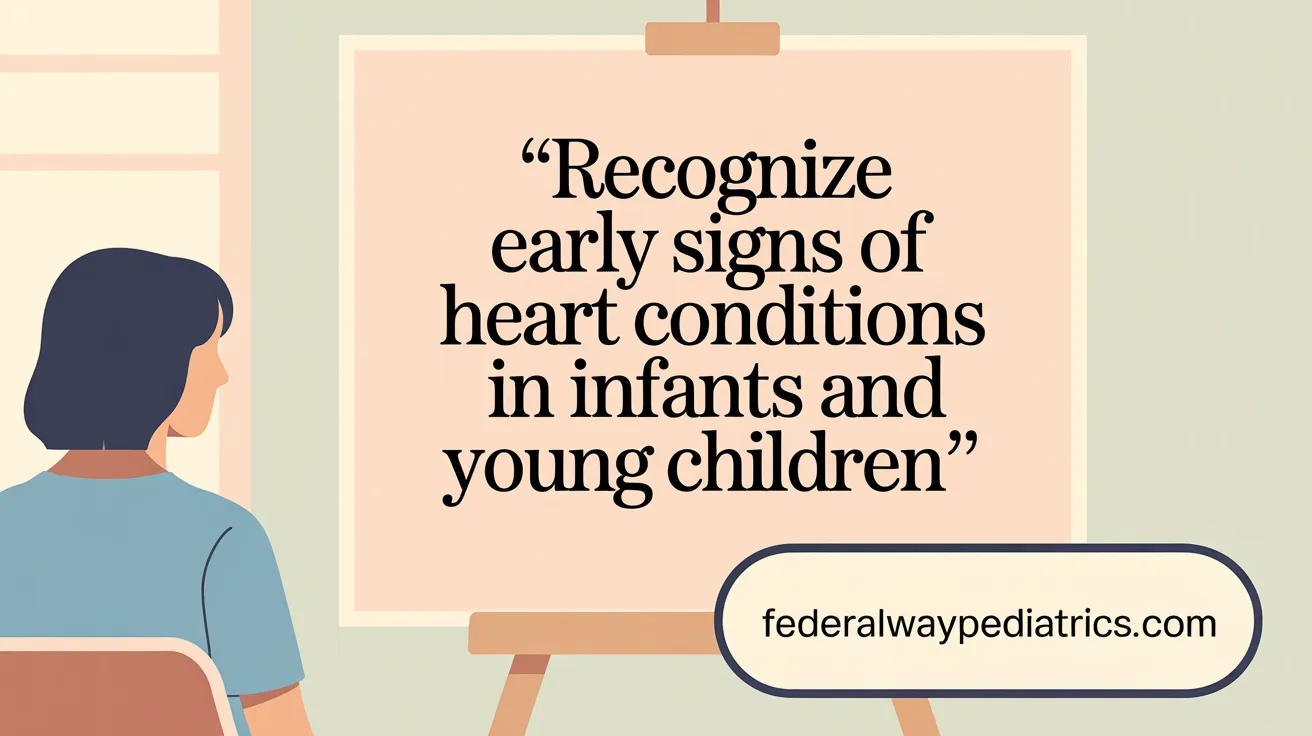
Symptoms in Infants
Heart problems in infants often present with signs related to feeding and oxygenation. Common symptoms include difficulty gaining weight and poor feeding, which occur because the heart struggles to supply adequate oxygen and nutrients during these critical growth periods. Cyanosis, a bluish tint around the lips, tongue, or nail beds, is an important visual indicator of oxygen deprivation. Additionally, infants may experience rapid or labored breathing and excessive sweating during feeds. Fatigue or tiredness while feeding is another crucial symptom, demonstrating the infant's reduced endurance due to cardiac inefficiency.
Symptoms in Toddlers and Young Children
As children grow, their activity levels increase, and heart symptoms may shift toward exercise intolerance. Young children with heart conditions might faint or pass out during physical activities, which signals inadequate blood flow or arrhythmias. Palpitations, or feelings of an irregular or rapid heartbeat, may also be reported. Shortness of breath during play and chest pain are other concerning signs that might indicate compromised cardiac function in this age group. These symptoms often prompt evaluation by a pediatrician to determine the underlying cause.
Differences in Symptom Presentation by Age
The presentation of heart disease symptoms varies with age. Infants predominantly show symptoms related to feeding difficulties and oxygen supply issues, such as cyanosis and fatigue during feeds. In contrast, toddlers and young children exhibit more activity-based symptoms including fainting, palpitations, and chest discomfort. This change occurs as the cardiovascular system is increasingly challenged by physical exertion in older children. Persistent symptoms or unusual signs, especially breathing difficulties or bluish coloration, require urgent medical attention to rule out critical heart conditions.
Prompt recognition of these signs facilitates early diagnosis and treatment, improving outcomes for affected children. For more information on signs of heart problems in children and teens.
Recognizing Heart Issues in Adolescents and Active Children
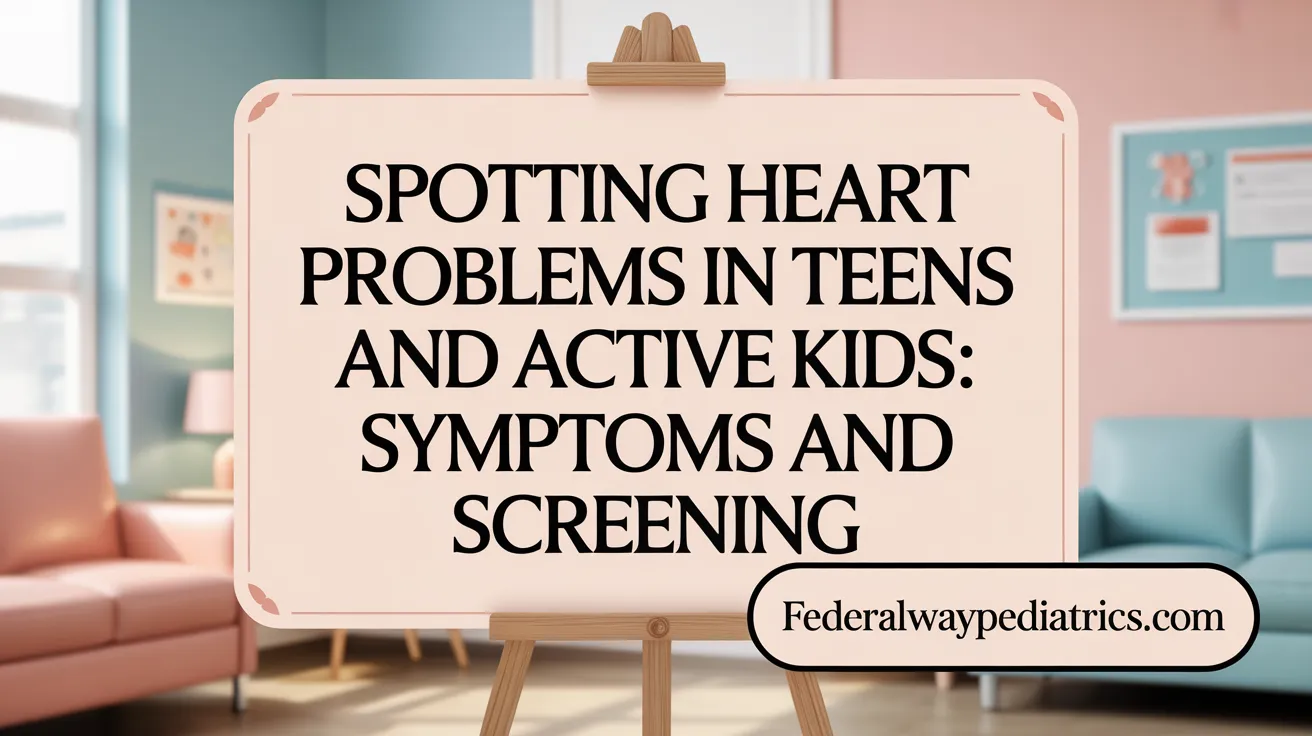
Symptoms common to teens
Adolescents with heart issues may show symptoms similar to those seen in younger children. These include chest pain during physical activity, heart palpitations, shortness of breath, dizziness, and fainting. Such symptoms warrant serious attention, especially when they occur during exercise or sports.
Risk and screening considerations for active adolescents
Screening is crucial for active teens, particularly those participating in sports or with a family history of congenital heart disease, sudden cardiac death, or arrhythmias like long QT syndrome. Early detection through detailed physical exams and possible referral to a pediatric cardiologist can identify underlying conditions such as arrhythmias or undiagnosed congenital defects, which might otherwise pose serious risks.
Importance of evaluation for chest pain and palpitations
While most chest pain in adolescents is benign, chest pain associated with vigorous exercise combined with dizziness or palpitations is a red flag and requires evaluation. Palpitations involving rapid heartbeats lasting over five minutes and accompanied by symptoms like chest pain or dizziness should also prompt medical assessment. Timely evaluation helps prevent complications and guides safe participation in physical activities and sports.
Diagnosis and Advanced Detection Techniques in Pediatric Cardiology
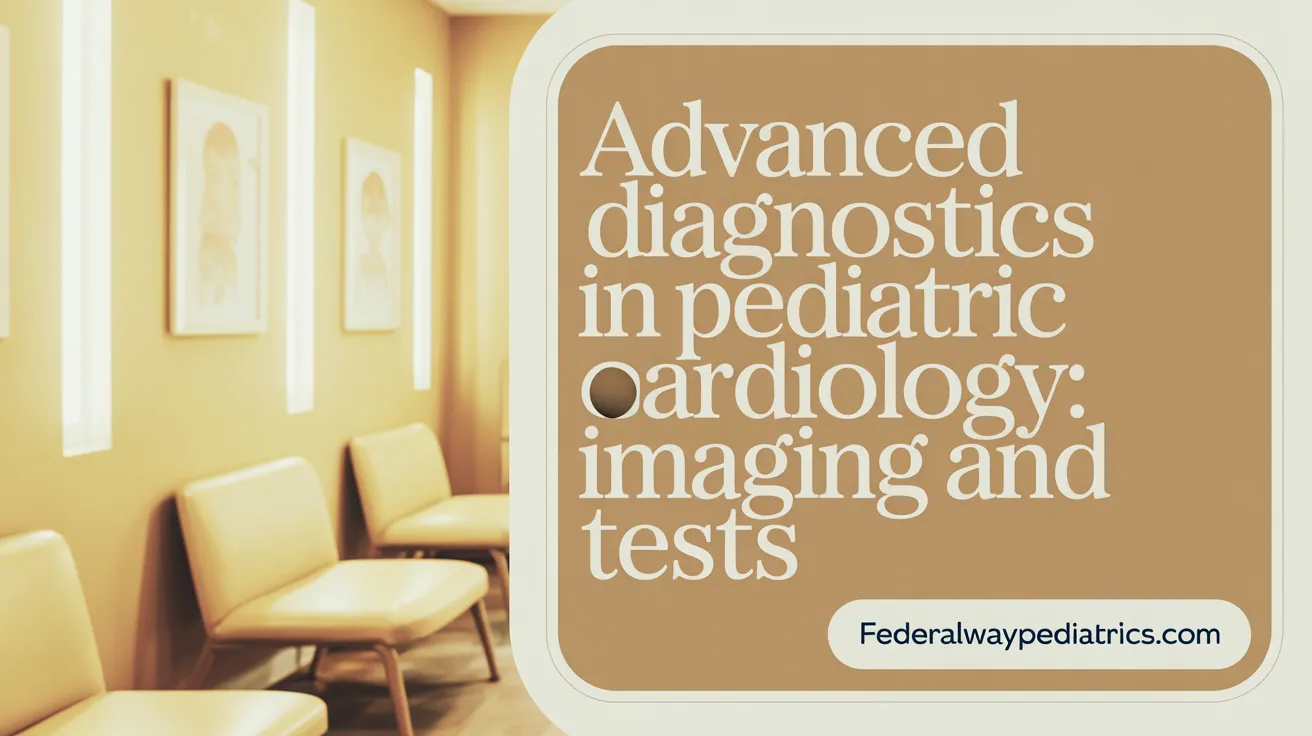
What diagnostic tools are used to detect heart conditions in children?
Diagnosing heart conditions in children involves a combination of clinical examination and advanced imaging technologies. Initially, a physical exam may reveal abnormal heart sounds, called murmurs, prompting further investigation.
Prenatal detection has improved significantly with fetal ultrasound and fetal echocardiography, enabling identification of congenital heart defects as early as the first trimester. This early diagnosis allows for better planning and intervention immediately after birth or even before.
Postnatal diagnostic tools include:
- Pulse oximetry: A quick, noninvasive test measuring oxygen levels to screen for cyanotic heart defects.
- Electrocardiogram (ECG): Records the heart's electrical activity, detecting arrhythmias or conduction issues.
- Chest X-ray: Assesses heart size and lung status.
- Echocardiography: The cornerstone imaging technique using ultrasound to visualize heart structure, valve function, and blood flow dynamics in real time.
- Cardiac MRI: Provides detailed images of heart anatomy and function without radiation.
- Cardiac catheterization: An invasive procedure to directly measure pressures within heart chambers and assess blood flow; also used for therapeutic interventions.
These diagnostic modalities combined help pediatric cardiologists accurately identify heart defects, both congenital and acquired, better define their severity, and guide appropriate medical or surgical treatment to improve outcomes. See Diagnosing heart conditions in children and Diagnostic methods for congenital heart defects for more information.
Common Types of Congenital Heart Defects and Their Implications
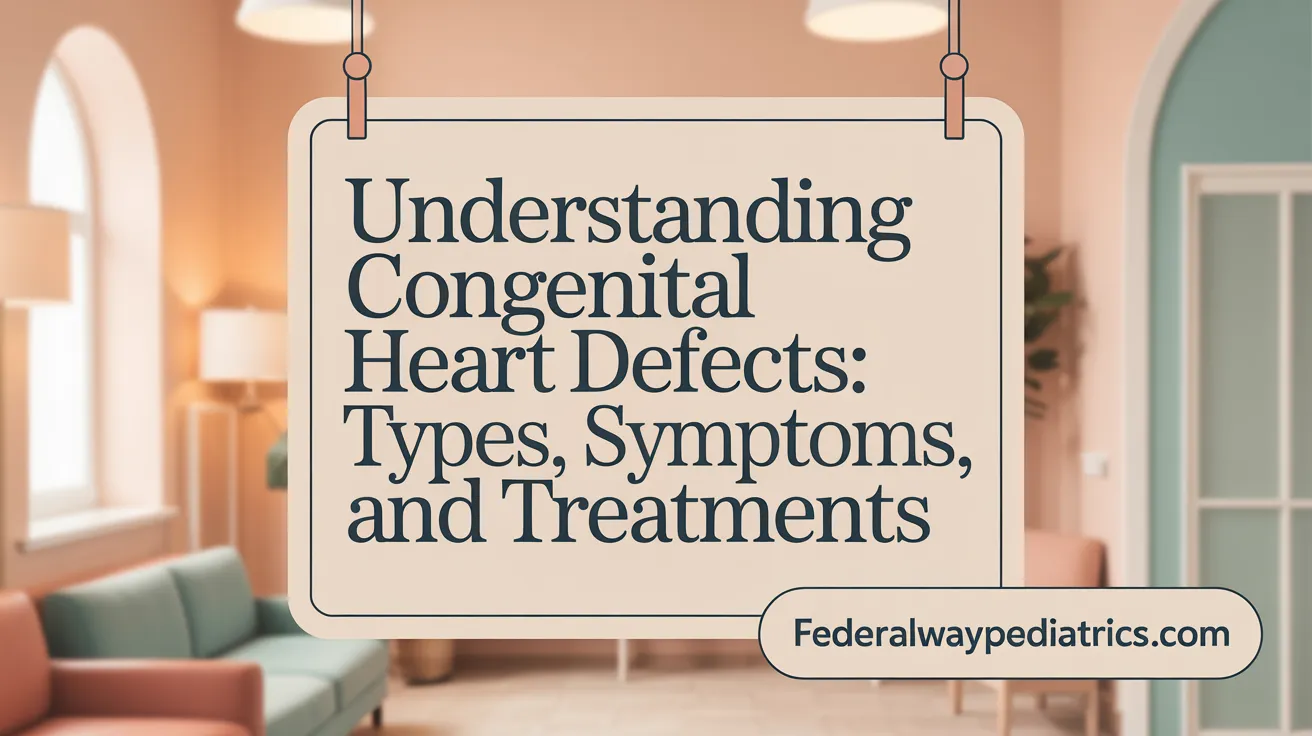
What are some common congenital heart defects and their clinical significance?
Congenital heart defects (CHDs) are present at birth and affect the normal structure and function of the heart. They occur in about 1 in every 100 newborns in the United States, with approximately 40,000 babies born annually with these conditions.
Some common types of CHDs include:
- Atrial Septal Defect (ASD): A hole in the wall between the heart’s upper chambers, which can allow oxygen-rich blood to mix with oxygen-poor blood.
- Ventricular Septal Defect (VSD): A hole in the wall between the lower chambers, affecting blood flow and oxygen delivery.
- Coarctation of the Aorta (CoA): Narrowing of the major artery (aorta) which can cause high blood pressure and heart strain.
- Tetralogy of Fallot: A combination of four heart defects including a hole in the heart and obstruction of blood flow to the lungs.
- Hypoplastic Left Heart Syndrome: Underdevelopment of the left side of the heart, a critical condition requiring early intervention.
- Patent Ductus Arteriosus (PDA): Persistence of a normal fetal blood vessel that should close shortly after birth, leading to abnormal circulation.
For more information on common types of heart defects, see Common Types of Heart Defects.
Severity and Symptoms
The severity of these defects varies widely. Some children may have mild or no symptoms early in life, while others experience signs such as:
- Cyanosis (bluish tint to skin or lips)
- Fatigue, especially with feeding or activity
- Shortness of breath
- Poor weight gain and growth delays
- Heart palpitations or irregular heartbeats
More severe defects, particularly those like hypoplastic left heart syndrome and complex combinations such as Tetralogy of Fallot, often present early and require prompt medical attention.
For a detailed list of symptoms indicating heart problems in children, see Symptoms indicating heart problems in children.
Treatment Approaches and Prognosis
Treatment depends on the type and severity of the defect. Options include:
- Monitoring: Some minor defects may resolve on their own or require periodic observation.
- Medications: To manage symptoms and improve heart function.
- Catheter-based Procedures: Minimally invasive techniques for certain defects to avoid open surgery.
- Surgery: Includes open-heart procedures to repair or replace parts of the heart.
- Heart Transplant: Reserved for the most severe, life-threatening cases.
Advances in pediatric cardiology have greatly improved the outlook for children with CHDs. Many affected children now survive into adulthood and lead full, active lives with appropriate treatment and ongoing care.
For more on treatment and prognosis, visit Congenital Heart Disease Overview and Signs of Heart Problems in Children and Teens.
Overall, early diagnosis and regular follow-up with specialized pediatric cardiologists are vital for optimizing outcomes in children with congenital heart defects. Information on choosing and consulting with a pediatric cardiologist can be found at Pediatric Cardiologist Consultation.
Acquired Heart Conditions in Children: Kawasaki Disease and Rheumatic Heart Disease
What are Kawasaki disease and rheumatic heart disease, and how do they affect children?
Kawasaki disease is a pediatric acquired heart condition characterized by inflammation of the coronary arteries and heart muscles. It mainly affects children under 5 years old and is more common in boys and children of Asian or Pacific Island descent. Typical symptoms include prolonged high fever, rash, bloodshot eyes, swollen lips, a bright red "strawberry" tongue, and swelling of the hands and feet.
Rheumatic heart disease develops as a serious complication following rheumatic fever, which itself arises from untreated streptococcal (strep) bacterial infections. This immune-mediated damage primarily targets the heart valves and can lead to long-term cardiac dysfunction. Although still a concern worldwide, rheumatic heart disease has become increasingly rare in the United States due to widespread use of effective antibiotics for strep throat.
Symptoms and affected populations
| Condition | Key Symptoms | Commonly Affected Groups |
|---|---|---|
| Kawasaki Disease | Prolonged fever, rash, red eyes, swollen lips, strawberry tongue, swollen hands and feet | Children under 5, boys, Asian or Pacific descent |
| Rheumatic Heart Disease | Valve damage, history of sore throat, heart murmurs, fatigue, chest pain | Children with untreated strep infections, more prevalent in low-resource areas |
Treatment considerations
Both conditions require early diagnosis and prompt treatment to prevent serious heart complications.
- Kawasaki disease is typically treated with intravenous immunoglobulin (IVIG) and aspirin to reduce inflammation and risk of coronary artery aneurysms (see more).
- Rheumatic heart disease management includes antibiotic therapy to eradicate strep bacteria, long-term antibiotic prophylaxis to prevent recurrence, and sometimes surgical intervention for valve repair or replacement if significant damage occurs (more info).
Careful follow-up with pediatric cardiologists is essential for children affected by these diseases to monitor heart function and intervene as needed. Awareness and timely medical attention can drastically improve outcomes for these acquired heart conditions in children.
Choosing and Consulting a Pediatric Cardiologist for Heart Conditions in Children
Criteria for selecting a pediatric cardiologist
When selecting a pediatric cardiologist, parents should look for professionals with extensive experience in pediatric heart conditions. Recommendations from trusted sources such as primary care physicians or other healthcare providers can guide parents to reputable specialists. Convenience matters too—choosing a cardiologist located near home or school facilitates regular visits. Access to a comprehensive care team, including cardiac surgeons and other specialists, is vital for managing complex cases. Additionally, the reputation of the hospital or center, known for advanced diagnostic and treatment capabilities, is an important factor.
Questions parents should ask
Parents should actively engage in consultations by asking how a specific heart diagnosis might impact their child's daily activities and lifestyle. Understanding the range of treatment options, associated risks, and possible outcomes is crucial. It is also important to discuss long-term management plans and how to recognize signs of complications. Clarifying the role parents will have in decisions and care routines helps them feel empowered and prepared for their child's care journey.
Role of multidisciplinary care
Comprehensive pediatric heart care is most effective when delivered through a multidisciplinary approach. This model incorporates cardiologists, surgeons, nurses, and support staff working together. Family inclusion and emotional support are integral to this approach, as managing heart conditions in children often affects the whole family. Such coordinated care improves medical outcomes and supports the child’s psychological well-being.
Empowering Families Through Knowledge and Early Detection
Pediatric heart conditions, whether congenital or acquired, present distinct challenges that require vigilant observation, timely diagnosis, and informed care. Awareness of the varied signs and symptoms across infancy to adolescence empowers parents and caregivers to seek appropriate medical attention early, significantly improving outcomes. Advances in diagnostic technologies and treatment methods have transformed prognosis, enabling many children to lead healthy, fulfilling lives. Choosing the right pediatric cardiology team and maintaining open communication are vital steps in managing these complex conditions successfully.
